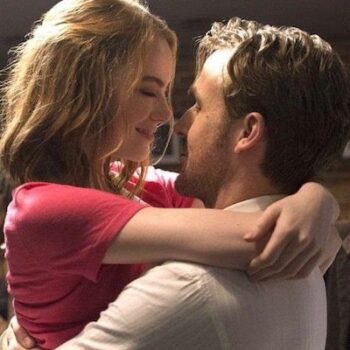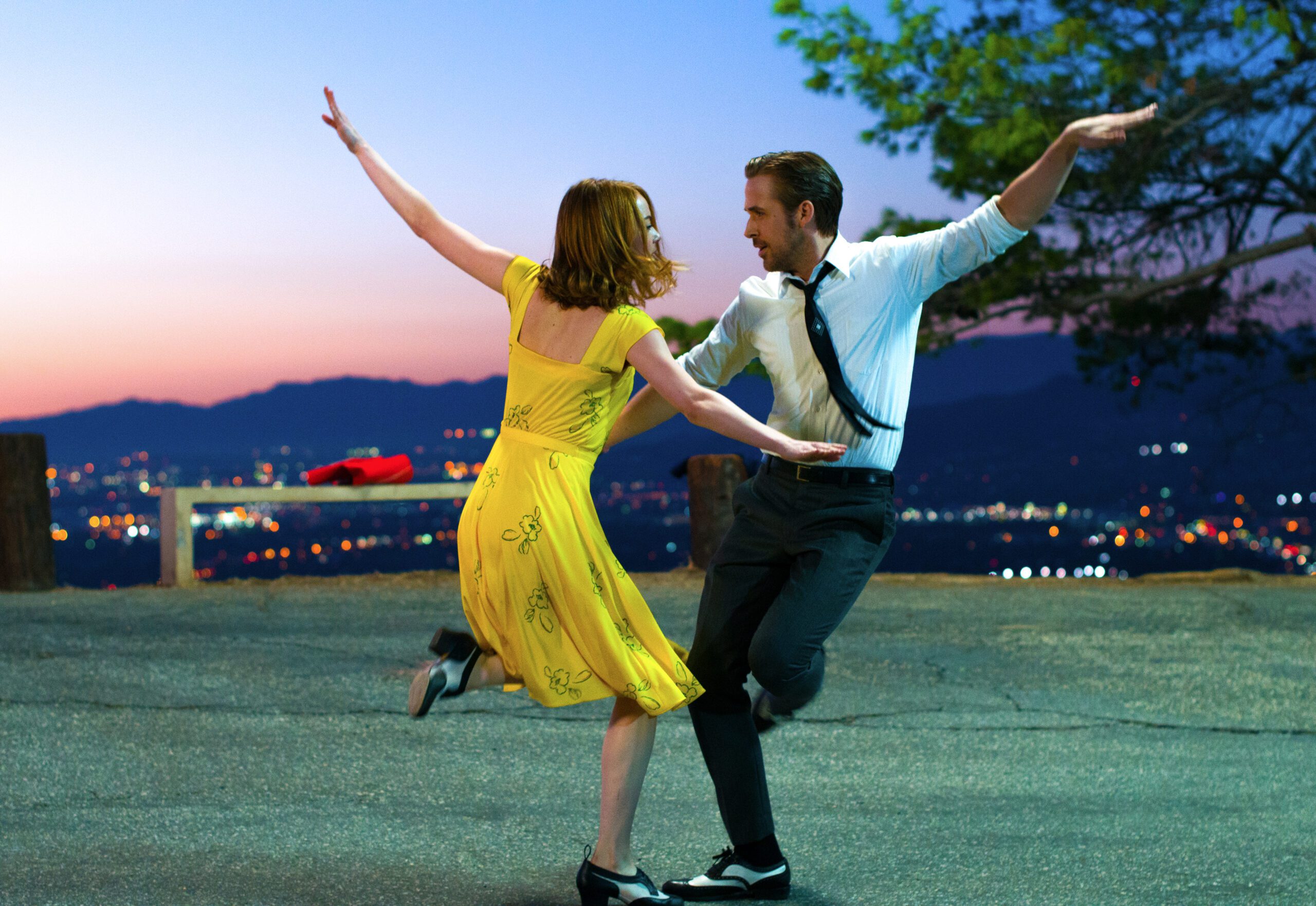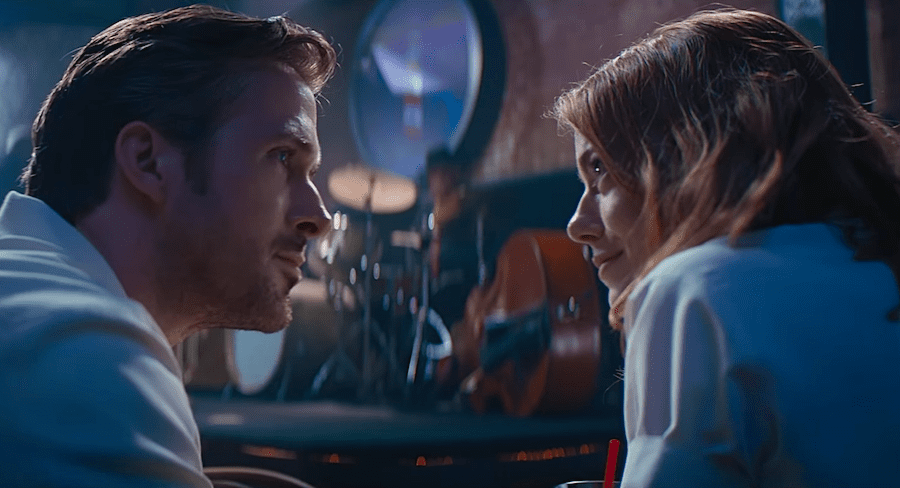
There’s a line with which Debbie Reynolds brilliantly seals her debut as Kathy Selden in the glorious 1952 Hollywood masterpiece Singin’ in the Rain: “If you’ve seen them once, you’ve seen them all.” She speaks about movies and she speaks the truth: the 1920s motion-picture industry has become old and boring, it needs to move with the times. In what seems a statement of little value, the actress sets the tone for the whole movie, spreading a leitmotiv that will define its revolutionary message and intents and which is, at some point, on almost everyone’s mind, if not lips. Her partner is a stranger yet charming, literally fell-out-of-the-sky Gene Kelly who’s just landed into her car from the top of a bus for no particularly practical reason at all. But we don’t need any reason and we wouldn’t ask why; the atmosphere is already set: we’re in a musical.
Close to this is what La La Land, the second promising outcome of Damien Chazelle’s artistic dedication after the multi-awarded Whiplash, instantly delivers: a story that’s both optimistic and melancholic, both romantic and truthful, often hidden behind melodies and beyond words, embedded in a dreamy reality. It is a matter of time before one realizes that the movie plays its cards right because it has it all: the grandiose overture, musically and choreographically (and purposely) astonishing offers itself as a great prelude to 127 minutes of intermittent tap and ballroom dancing, heart-breaking ballads, swing notes and revived 80s rhythms (most notably A-ha’s “Take On Me”), and a whole world of old-cinema references scattered throughout a contemporary LA—all wonderfully orchestrated under Chazelle’s meticulous direction.
Far from being a “seen one, seen them all” kind of movie, La La Land carries the mark of an ambitious director as it draws on the trailblazing legacy of the Golden Age Hollywood musicals. Back then, the aim was to launch a unique and comprehensive lesson in style—via singing, dancing, acting—by being so persuasively alive. Similarly, Chazelle’s purpose for this movie seems to be a need of emancipation from what by now we’ve long been accustomed, and yet—in a classy exhibition of professionalism, humility and self-irony—also a declaration of its novelty only to the extent that it digs up the musical movie genre within the pretty much unaltered laws of the dream factory system. He goes back to the French musicals of Jacques Demy as his primal source of inspiration and emotional engagement, Les Mademoiselles de Rochefort or Les Parapluies de Cherbourg above all—the latter being peculiarly piercing and starring a lovely, pastel-like portrayed Catherine Deneuve whose mellifluous voice clashes with her broken heart.
Dreams are La La Land’s driving force; they heat, brighten up and challenge the lives of those who truly live for them. But for Mia (Emma Stone) and Sebastian (Ryan Gosling)—two dream hunters whose different aspirations reconcile in the way they envision a fulfilling life for themselves—they become the ground for each other’s love.
Both are not quite where they wish they were: she works as a barista at the Warner Bros. Studio lot café, one step away from Casablanca’s set and Ingrid Bergman’s balcony, and he is a piano bar pianist who fantasizes about owning a place where only the purest expressions of jazz are unleashed. Chazelle chooses to deal with their falling in love in a funny, sweet, unpredictable manner. Taking over conventions and clichés of how love is supposed to be onscreen, here romance renews itself with a sparkle of authenticity, whilst never fading, since the movie begins and ends in a cloud of sentimentalist nature that it manages to superbly celebrate. A smart choice among the many others, the movie trailer mystifies us with nostalgic, rose-tinted scenarios in order to elude (maybe as a later element of surprise) the much enjoyable humorous tone that pops up every time the witty Gosling-Stone match, whose straightforward chemistry we’re by now sincerely fond of, plays the lovers in question. “Once you get to learn how to ballroom dance with someone, then you got to learn everything you need to know,” Stone joked around in a press conference. Their love story begins as a collection of casual, unpleasant encounters before the first arranged one—a night rendezvous at the cinema—where they both must, not without a bit of reluctance, persuade themselves that they feel rather the opposite of hating each other, in a lovely replica of the refreshing, provoking, and unique back-and-forth humor à la Cary Grant and Katherine Hepburn.
Just as with Whiplash and, even before, with Guy and Madeline on a Park Bench—his first, not at all timid exercise in direction—Chazelle’s filmmaking revolves around the luminous, massive presence of music. “Music is always going to form what I do and the way I do it,” he said at the Venice Film Festival premiere (where the movie earned its first award, Coppa Volpi for Stone’s performance), formalizing the role of musical as a natural way of conveying his passion. That’s why La La Land so much reminds of a melody, of a symphonic repertoire or of a sheet music that’s played even when actors are just talking or walking. The director has his own code for shooting and it feels just poetic: the camera is like a counterpart to the dance, as choreographed as the dancers so as to move in a way that feels musical and in harmony with the actors’ speech patterns rhythms. He treasures the golden rule that made old musicals timeless: “No one breaks into a song,” he explains, “unless it’s emotionally justified.” And he knows how to apply it: Stone and Gosling don’t dance or sing just because that’s what we’re expecting from a musical; they dance and sing because in that precise moment it’s all they have and need to express themselves thoroughly.
As suitable and appealing as Stone’s metaphor for the movie sounds—La La Land is “a lush love letter”—it is arguably more about dreams than it is about love. But how to stage a dreamer, the matter of his dreaming? Fantasy needs its own language to depict its inconsistency, its evasiveness, even from reality logics.
For their first date, Seb and Mia go to see Rebel Without a Cause at the Rialto Theatre in Pasadena; immediately after, you can admire them lifting off the ground and floating in the air, suspended in a gravity-free dance among the stars. What allows them to deceive space and time only to land at the Griffith Observatory (not by chance, one of Rebel Without a Cause’s locations) as if it was where they were always meant to be is the magical realism that charmingly pervades the movie. The planetarium, as a concrete place, turns into a fantastical one the moment that it becomes the object of their daydreaming: the boundaries of what is real and what is not fade easily in a city that is one of the movies’ greatest birthplaces, where life constantly meets the artificial.
Chazelle laid the city’s underpinning balance bare as he recalls his first impression on it that “doesn’t feel like a real place.” Fantasy needs reality “because it’s only with the real backdrop that it works at all,” and reality needs fantasy to challenge its façade. Precisely because it is a movie-sets land, Los Angeles is the ultimate dream-sets land, where the unrealistic takes shape.
La La Land is built on opposites: it is an old modernity, where it may be that the tunes of a well-known iPhone ringtone interfere with two lovers dancing in the footsteps of Fred Astaire and Cyd Charisse in The Band Wagon (1953), where a fantastical reality takes place and where sadness can be of the sweetest, warmest form. To Variety the movie is “the most audacious big-screen musical in a long time, and—irony of ironies—that’s because it’s the most traditional.” Flexible contradictions are what make it work so strikingly. Chazelle hit the right chord by bringing on the screen what we’re missing—hope and romance “now more than ever”—and he couldn’t have been more realistic nor timely: we need something as unconventional and old-fashioned as the concept of optimism nowadays. Far from being a mere display of stylistic inventiveness for its own sake, the onscreen magic of the movie wants to be a message that, regardless of how fantastical our desires may be, off-screen magic is possible.
La La Land is, after so much time, a contagious ode to the power of dreams—a dedication within a song, ”Audition,” that Emma sings, with all the strength of her beauty, straight to us: “Here’s to the ones who dream / foolish as they may seem…”
***
Image credits: feature image, image 1, image 2, image 3.







